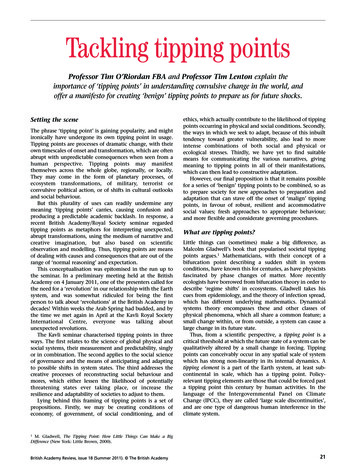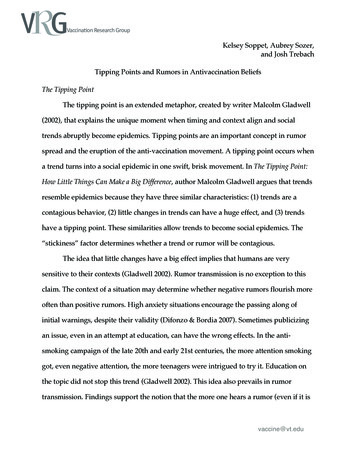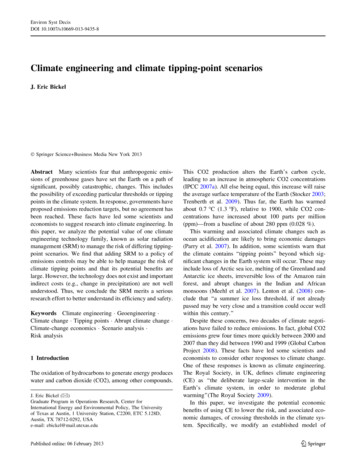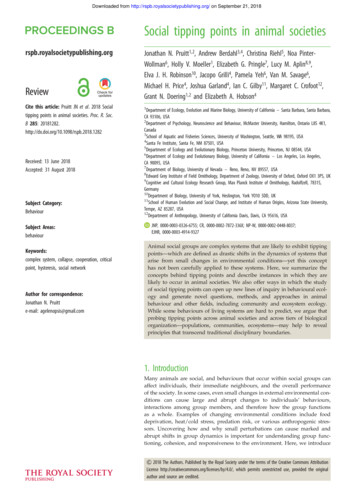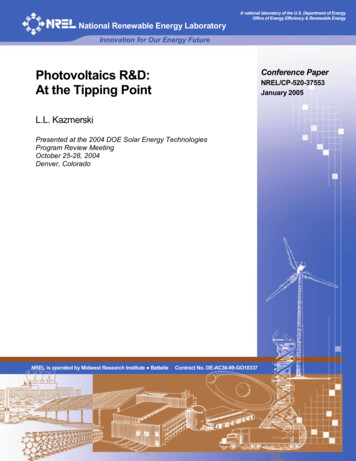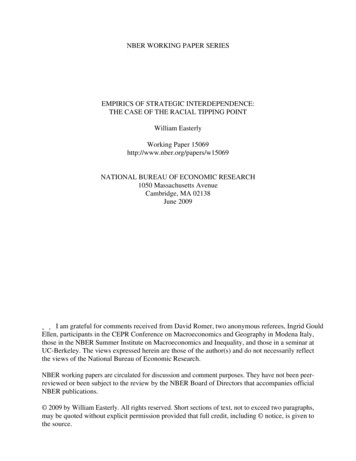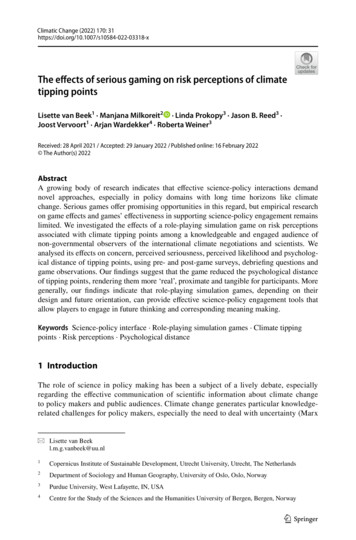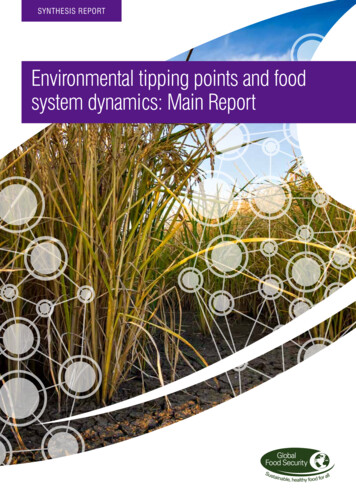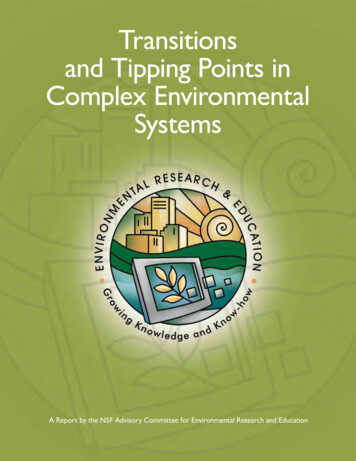
Transcription
Transitionsand Tipping Points inComplex EnvironmentalSystemsA Report by the NSF Advisory Committee for Environmental Research and Education
About the Advisory Committee for Environmental Research and EducationIn 2000, the National Science Foundation (NSF) established the Advisory Committee forEnvironmental Research and Education (AC-ERE) under the Federal Advisory Committee Act(FACA) to: Provideadvice, recommendations, and oversight concerning support for the NSF’senvironmental research and education portfolio. e a base of contact with the scientific community to inform NSF of the impact of its researchBsupport and NSF-wide policies on the scientific community.S erve as a forum for consideration of interdisciplinary environmental topics as well asenvironmental activities in a wide range of disciplines. Provide broad input into long-range plans and partnership opportunities. erform oversight of program management, overall program balance, and other aspects ofPprogram performance for environmental research and education activities.The AC-ERE has a particular interest in those aspects of environmental science, engineering, andeducation that affect multiple disciplines. Each of the directorates and major offices of NSF has anadvisory committee that provides guidance on the disciplinary activities within that directorate.The AC-ERE includes scientists from many disciplines, including a member from each of theother NSF advisory committees, and focuses on coordination, integration, and managementof environmental programs across the Foundation. AC-ERE interests include environmentaleducation, digital libraries, and cyberinfrastructure, as well as interdisciplinary programs, centers,and major instrumentation.Additional information can be found at: http://www.nsf.gov/geo/ere/ereweb/advisory.cfm
Transitions and Tipping Pointsin Complex Environmental SystemsJUPITERPrologue Deterring Unprecedented Social Upheaval: Now is The Time to Act.2Executive Summary.4Recommendations.9A Call for Action. 12Environmental Challenges. 13Interdisciplinary Opportunities.15Earth: Our Planet As We Know (Knew) It. 17Sidebar: Dust, Oceanic Phytoplankton, and Climate Change. 17The Rapid Progression of Our Environmental Challenge: A World without Recent Parallel.18Sidebar: A Disappearing Sea—A Place Blighted.19Research Priorities .22New Strategies for a New Era.23Thinking About the Whole—Not Just the Pieces.24“Tragedy of the Commons” Becomes Collective Wisdom if Choices are Enforced.26Sidebar: Apalachicola-Chattahoochee-Flint Drainage Basin.27Tipping Points in Complex Environmental Systems .28Sidebar: From the Corn Belt to the Gulf of Mexico’s “Dead Zone”.29Promoting Integrated Science and Engineering to Tackle Environmental Challenges.31Sidebar: Bluer than Blue: Tipping Point for Glacier Melt.32Sidebar: Changing States: Social System Resilience and Recovery.33Networks for Environmental Research.36Sidebar: A History of Change in Coupled Natural Human Systems.39Environmental Literacy.40Moving Beyond Changing Light Bulbs .41An Environmental Literacy Framework: Learning What We Need to Learn.41Formal Environmental Education.42Informal Environmental Education.44Engaging the “Citizen Scientist” in Environmental Research.46Sidebar: Environmental Decision-Making in a World of Uncertainty.49Epilogue.50Glossary.53Mike Usher, NSFAcknowledgments.54Transitions and Tipping Points in Complex Environmental Systems1
PROLOGUEDeterring Unprecedented Social Upheaval:Now is The Time to Act2
SNOAAhishmaref is a village five miles fromthe Alaskan mainland on SarichefIsland in the Chukchi Sea. Globalwarming has resulted in less ice inthe Chukchi Sea, ice that providesnatural protection to the island’s coastalshores against powerful storm surges.While the coastlines are eroding fasterthe land underneath the village isfalling into the voids caused by meltingpermafrost. Shishmaref is sinking.Sarichef ’s coastline is receding at up to threemeters annually and barricades have failed tokeep the ocean at bay. Buildings and roads havebeen lost to erosion and basic infrastructureis being compromised. Winter ice on theChukchi Sea is softer and less stable, affectingocean travel and impacting the indigenousInupiaq people’s traditional hunting and fishingactivities, jeopardizing both their safety andfood supply. The village’s very existence—physical and cultural—is at risk.JUPITERShishmaref is both outpost—offering havento explorers and seafarers for centuries—andfrontrunner—as one of those places mostaffected by climate change. The increasing riskto property and lives has forced the communityto consider abandoning their island and beginplanning to move their village to the mainland.Even if they can find a suitable location andraise the estimated 180M to finance themove, the cultural and social integrity of thecommunity will be intimately affected. TheInupiaq describe their fate as a harbinger forthe rest of the world.Transitions and Tipping Points in Complex Environmental SystemsThe vast region encompassed by Alaska is onthe front lines of climate change, experiencinga rise in average winter temperatures of morethan four degrees Celsius in the last 60 yearsand potentially another five to nine degrees bythe end of this century. The state’s arcticand subarctic ecosystems already aretransforming from what Americansrecognize as The Last Frontier state.Spruce bark beetles have respondedto changing ecological conditions byinfesting the forests, wiping out millionsof hectares of spruce trees on the KenaiPeninsula in the past two decades, the largestloss ever recorded in North America caused bythis beetle. In today’s warmer, drier weatherAlaska is suffering its most destructive fireseasons, claiming millions of hectares of forestand the trend is clearly showing increasedfrequency with each passing year. Freshwaterbodies throughout Alaska are evaporatingor draining at unprecedented magnitudes,changing the landscape.MICHELLE KELLEHER, NSFThe people of Alaska will respond to theseenvironmental challenges in ways that mayalter their culture and economy. But there isno clear roadmap of consequences to serve asguide for the choices they face—choices wewill all eventually face. They are decisionsmade by people everywhere, individually andcollectively, decisions motivated by incentivesand rewards that are local and short-term, thatin aggregate cause environmental changes thatare global and long-term.3
EXECUTIVE SUMMARY4
The Advisory Committeefor Environmental Research andEducation advises NSF on itssupport for research and educationin the environmental sciences,which figure prominently in NSF’sStrategic Plan 2006-2011.1 A short3 years into that plan, we concludethat fundamental research and widelydispersed education are not progressingat the pace required by the magnitudeand urgency of the environmental challenges that face this nation and all societies.NSF should increase its commitment to itsinvestment priorities to: “Foster research thatimproves our ability to live sustainably onEarth” and “To strengthen our understandingof the links between human behavior andnatural processes.”The NSF is well-suited to lead a reinvigoratedscientific initiative in the environmentalsciences. The agency already provides broadsupport for the disciplines that are criticalfor environmental science, including thebehavioral and life sciences, the earth andatmospheric sciences, the social sciences,and the mathematical, physical, engineering,and information sciences. The substantialchallenges facing us in the environmentalsciences will require research that integratesall of these disciplines. Accordingly, werecommend NSF place a high priority oninterdisciplinary activities that integratethese components. The goals of this effortmust be to provide a better understandingof complex environmental systems, a higherlevel of environmental literacy in the public,and a stronger foundation for informingpolicy decisions for addressing globalenvironmental issues.NASA1National Science Foundation. 2006. Investing in America’s FutureStrategic Plan FY 2006-2011. NSF 06-48, 24pp.Transitions and Tipping Points in Complex Environmental SystemsNSF cannot change our collective approach toenvironmental issues by itself. The challengesare multifaceted in nature and large in scale andNSF must join with other agencies to promotethe strongest effort that the community’sscientific talent can muster. Moreover,interdisciplinary priorities for NSF andother agencies will not achieve all thatthey could achieve if the institutionalpractices within the research andeducation communities are not adapted tofacilitate interdisciplinary action.The need for equitable, ethical, and sustainableuse of Earth’s resources by a global populationthat nears the carrying capacity of the planetrequires us not only to understand howhuman behaviors affect the environmentbut also how human behavior changes inresponse to changes in the environment orperceptions of environmental status. Thecommittee recommends that the approachto environmental literacy bridge the gapbetween the academics who do the research,the tool developers who design curricula andapplications, and the communicators andeducators who translate the science into termsthat can be broadly understood by policymakers and the public.These goals of bold interdisciplinary researchand public engagement will be difficult toaccomplish and conducting research andeducation via a model of “business as usual”will be insufficient. Current practices inacademic and government institutions, withtheir traditional disciplinary funding andevaluation mechanisms, often inhibit thetruly innovative and integrative science andeducation the nation needs. NSF shouldadopt organizational and review strategiesthat promote interdisciplinary innovationand ensure that programs funded forinterdisciplinary activities have the longevity5
CHALLENGE: LITTLE TIME TO ACTThe rate of environmental change is outpacingthe ability of institutions and governmentsto respond effectively. Issues that previouslywere addressed at the local level are no longeradequately understood without a regional,continental and, increasingly, global perspective.While we recognize the direct connectionbetween local human activities and globalenvironmental changes, the feedbacks of thatchange on regional ecological and social systemsare poorly understood. The issue is not just spatialscaling; there is also the temporal disconnectbetween environmental changes and the humanactions that cause them and the policies designedto address them. We must rapidly increase ourability to forecast change in globally connectednatural and human systems, or find ourselvesresponding increasingly to crises.necessary to attract scientists to workcollaboratively across the disciplines.CHALLENGE: INCREASING STRESSON THE PLANETThe world is at a crossroads. The globalfootprint of humans is such that we arestressing natural and social systems beyondtheir capacities. We must address thesecomplex environmental challenges andmitigate global scale environmental changeor accept likely all-pervasive disruptions.Rapid development and growth of humanpopulations are causing changes to naturalecosystems and biodiversity loss of amagnitude and scale not seen before duringhuman existence. Environmental challengesare increasingly of a global scale; while manychanges appear small individually in aggregatethey have large and even synergistic effects.At the same time technological advances arechanging lifestyle and social norms on everylevel as well as livelihood patterns. As thesesocioeconomic systems have become moreglobally connected and interdependent so toohave their interactions with environmentalsystems. These changes in environmental andsocial systems represent serious threats to oureconomy, security, and human health.DHSThe global footprint of humans is suchthat we are stressing natural and socialsystems beyond their capacities.6CHALLENGE: NEW RESEARCHNEEDEDEnvironmental science must move beyondidentifying issues and toward providing soundbases for the development of innovativesolutions, effective adaptation, and mitigationstrategies. To accomplish this goal we urgentlyneed to expand our capacity to study theenvironment as an integrated system thatincludes the human dimension. Humans areinextricably embedded within supportingenvironmental systems. To understandthis coupling of natural and human socialsystems, we must advance general conceptssuch as ecosystem services and describe theprocesses that link natural systems, from localto global scales, with human systems fromindividuals to collectives. Incorporating the
VSeehuman component will require long-term,regional-scale research that addresses howindividual behavior, demography, and socialsystems respond to changes in the functioningof environmental systems. While scientistsfrom every discipline can make significantcontributions, studying the components ofenvironmental systems in isolation from eachother is neither adequate nor meaningful. Toaddress the environmental challenges thatconfront us we must find ways to integrateand synthesize data from diverse fields into awhole-systems perspective, taking into accountthe complications of interactions occurringon different spatial and temporal scales. Weneed to better anticipate thresholds of rapidtransition—tipping points—in complexenvironmental systems. Natural and humansystems alike are changing in ways that areTransitions and Tipping Points in Complex Environmental Systemspoorly understood. How far and in what wayscan these systems be stressed before they reachtipping points, i.e., undergo rapid transition tonew states with unforeseen consequences? Wemust grapple with the complexity that emergesfrom the processes inherent in coupled naturalhuman systems to understand and, wherepossible, forecast and manage their dynamics inthe context of a rapidly changing environment.OPPORTUNITY: A PERVASIVELYNETWORKED PLANETDevelopments in cyberinfrastructure arechanging how we conduct science and howscientists interact with each other and withthe public. The tremendous potential ofsensors and observational networks to gatherconsistent data on many variables is critical toresponding to the environmental challenges7
DEZHEN SONG, TEXAS A&M UNIVERSITYOPPORTUNITY: ENGAGETHE PUBLICWithout an informed knowledge base,citizens and policy makers are ill-equippedto make responsible decisions about ourenvironmental future. Although elements ofenvironmental science are included in currentformal and informal education, most effortsfail to integrate them into a framework thatpromotes environmental literacy throughunderstanding of the linkage between naturaland human systems. Differing perceptionsand values on the relationship betweenMARA CHERKASKYwe face. These networks have the capabilityto monitor conditions across broad spatialand temporal scales and allow us to examinenew kinds of variables, including those inthe social sciences. Cyberinfrastructureenables the sharing of vast amounts of datawhich broadens the involvement of peopleand institutions and encourages collaborationand open source innovation. This fosters theinterdisciplinary connections and synthesisneeded to address complex environmentalchallenges. Just as the first view of planetEarth from space helped crystallize a globalperspective and an environmental awareness,the advent of global, interconnected, andinterdisciplinary data networks will beimportant in fostering international, collectiveaction to address environmental problems.8
OPPORTUNITY: NSF UNIQUELYPOSITIONEDNSF is the only federal agency that supportsall fields of science and engineering necessaryto understanding complex, coupled naturalhuman systems. Through NSF’s effortsto encourage interdisciplinary research,the agency is uniquely poised to fosterinnovative research that improves our abilityto live sustainably on Earth. But the paceof this interdisciplinary research is woefullyinsufficient given the urgency of our2Richard Louv. 2005. Last Child in the Woods: Saving Our Children from Nature Deficit Disorder. Chapel Hill: Algonquin Books.Transitions and Tipping Points in Complex Environmental SystemsJUPITERpenelope firth, nsfhumans and environment are the foundationupon which cooperative behaviors criticalto managing the environment must bebuilt. The networked world opens up newopportunities to engage the public, increaseenvironmental literacy, and change theway we approach environmental science.Within this decade over 5 billion peoplewill be connected through cell phonesand the Internet. This comes at a timewhen many younger people are spendingless time in the natural environment.2 Aconnected generation is growing up with anew capacity for collaboration and interestin social experimentation enabled by newcomputing and communications platforms.In this digitally connected and sociallynetworked world, people are no longerpassive consumers of information. Theyinteract with and contribute to informationand co-create solutions in cyberspace. Thisinvites exciting new avenues for learningopportunities that meaningfully connectpeople to their environment through dataand models. It is time to ask how we can bestpromote environmental literacy by engaginga cyber-connected society for the benefit ofenvironmental science.environmental challenges. If NSF is to be aneffective agent of change in environmentalresearch, greater priority must be given toadvancing an integrated approach to earthsystems and addressing the complexity ofcoupled natural-human systems from local toregional to global scales.RecommendationsIt is imperative to increase ourunderstanding of coupled natural-humansystems through increased support for broadlyinterdisciplinary environmental research. Suchresearch should be responsive to the urgentneeds of society for knowledge that addressesour environmental challenges and informs amore sustainable way of life. We mustunderstand better the complications ofprocesses that operate on different scales andthe feedbacks that can trigger abrupt change inenvironmental systems. Such understandingwill maximize our ability to predict thresholdsof change, design remedial actions that moveus away from those thresholds, and identify19
Alejandra Restrepo-Correa, Florida Institute of TechnologyNSF must evolve from its primarilydiscipline-centered organization to onethat better promotes and supportsinterdisciplinary approaches, and attractsmore scientists and engineers to engage incollaborative and integrative research andeducation that addresses the nation’senvironmental challenges. To achieve this,NSF must increase the size and longevity offunding programs that support broadlyinterdisciplinary research, i.e., programs thatspan multiple NSF directorates. Sustainingsuch programs on a time frame relevant to thecareer paths of individual researchers isnecessary to facilitate cross-disciplinarydialogue and synergistic collaboration. TheDynamics of Coupled Natural and Human210Systems, originally supported through theBiocomplexity in the Environment initiative,serves as a prominent example of this type ofcross-directorate activity. NSF should exploreadditional models of promotinginterdisciplinary research, including newpartnerships with other federal agencies,foundations, and the private sector, and newways of conducting peer review so as to fostermore collaborative and innovative approaches.NSF should lead the effort to ensure theimplementation of a well-designed andintegrated system of observational sensornetworks that measure critical environmentalvariables as well as the changes in key humanactivities with environmental consequences.3Center for BioModular Multi-ScaleSystems, Louisiana State Universitypathways of adaptation in response to change.To this end, NSF’s directorates and officesshould all adopt the study of coupled naturalhuman systems as an important part of theircore missions, from the study of the physicaland biological factors that drive these systemsto an understanding of the human responses toalteration in systems states.
Charles Nilon, Baltimore Ecosystem Study LTER Project and Universityof Missouri-ColumbiaThis effort should be well-coordinated withother federal agencies and governments toensure that data can be shared across networksand to maximize the opportunities forsynergy. The priority for NSF in creatingenvironmental observatories should be tofacilitate research needs, as stated above, andto better link site-based and experimentalstudies to long-term observations spanningregional to global scales. Related to this goal isa need to ensure long-term stewardship ofdata. NSF should require that all proposalsprovide plans for management, accessibility,and preservation of data to be collected duringa project, and evaluate those plans as part ofthe peer review process.We must redouble efforts to promotenew and participatory approaches toenvironmental education and public engagementthrough formal and informal venues. A higherlevel of environmental literacy is essential if weexpect to persuade the general public to adoptbehaviors that will help solve environmentalproblems. An environmental literacy frameworkgrounded in basic concepts that integrate4Transitions and Tipping Points in Complex Environmental Systemsdisciplines into a holistic perspective of Earth’snatural and human systems should be developedfor K-20 education and beyond.We must help policy-makers develop abetter understanding of complexenvironmental systems, an understanding thathelps them appreciate the concepts of tippingpoints, the thresholds of large magnitude orabrupt change, and the socio-economiceffects of severely altered environmentalsystems. Tools must be developed that assiststakeholders to visualize and synthesize datafrom multiple sources. We call for theadvancement of decision support tools thatintegrate knowledge across disciplines toaddress long-term consequences. Policymakers and the general public must beengaged in activities that lead to a betterunderstanding of the interconnectednessof environmental challenges such as wateravailability, biodiversity loss, populationgrowth, and energy demand, and of theuncertainties we face in making predictionsin an era of rapid environmental andsocial change.511
A CALL FOR ACTION12
The Advisory Committeefor Environmental Research andEducation (AC-ERE) serves toreview and advise NSF on itssupport for research and educationin the environmental sciences. Thecommittee was established in responseto a report issued by the NationalScience Board in 2000, “EnvironmentalResearch and Education for the 21stCentury.” That report recognized thatenvironmental science and engineeringare intrinsically multi-disciplinary and mustinvolve all parts of NSF. Hence, the membersof the AC-ERE are representative of all fieldsof research and education supported by theFoundation. A report was last issued by theAC-ERE in 2005 yet in the brief time since,the public’s concern with rapid environmentalchange has grown, and with it a call for action.In this report, the AC-ERE reviews whatnew knowledge is most critical to address theenvironmental challenges that confront us.to act. The costs of ignoring these changes,environmental, economic and social, maybe catastrophic. While climate change isthe most obvious illustration of this fact, itis not the only phenomenon. Populationgrowth and technological changes alterthe pattern of human settlement andlivelihoods, creating inequalities andshifts in social norms which in turndifferentially increase the demand forenergy, food, and water and stress bothsocio-economic and environmental systems.Because environmental and social systems arestrongly interconnected (i.e., coupled naturalhuman systems), stresses in one increase thevulnerability of both systems to disruptions.In this connected world, disaster in oneregion or system can too easily cascade toothers. We need to understand which of thecoupling relationships are loose and which aretight, the mechanisms that contribute to theresilience of coupled natural-human systems,and the feedbacks among their componentsand processes that link these systems at local,regional, and global scales.DHSWhen a system is pushed by naturalor social stresses to a tipping point thefeedbacks from that abrupt change canbe unpredictable.Environmental ChallengesKaye Evans-Lutterodt/Solar DecathlonThe current state of the environmentpresents urgent challenges for scientistsin the natural, social and behavioral sciences.Human actions have impacted all parts of theglobe with resulting changes in the structureand functioning of environmental systemsat all scales. Yet the public has been slow toacknowledge these changes and even slowerTransitions and Tipping Points in Complex Environmental SystemsOur scientific appreciation for the complexityof interactions within coupled natural-humansystems has grown vastly and so has oursense of urgency to understand and forecastchange. We are at a time of unprecedentedopportunity—and beyond opportunity,necessity—to address environmental and socialchallenges unprecedented in the history ofmodern civilization. Continuing to ignorethese changes limits our abilities to mitigate or13
adapt to their consequences. Yet, the state ofthe science in understanding the dynamics ofcoupled natural-human systems is inadequate tomake predictions about when and where suddenchange will occur and how to use science andeducation to better shape our future.Understanding of transitions, tippingpoints and abrupt changes in complexenvironmental systems will alsobenefit from greater involvement ofmathematics and computer science inthe environmental sciences as well asinvestments in cyberinfrastructure
Transitions and Tipping Points in Complex Environmental Systems 3 S hishmaref is a village five miles from the Alaskan mainland on Sarichef Island in the Chukchi Sea. Global warming has resulted in less ice in the Chukchi Sea, ice that provides natural protection to the island's coastal shores against powerful storm surges.
